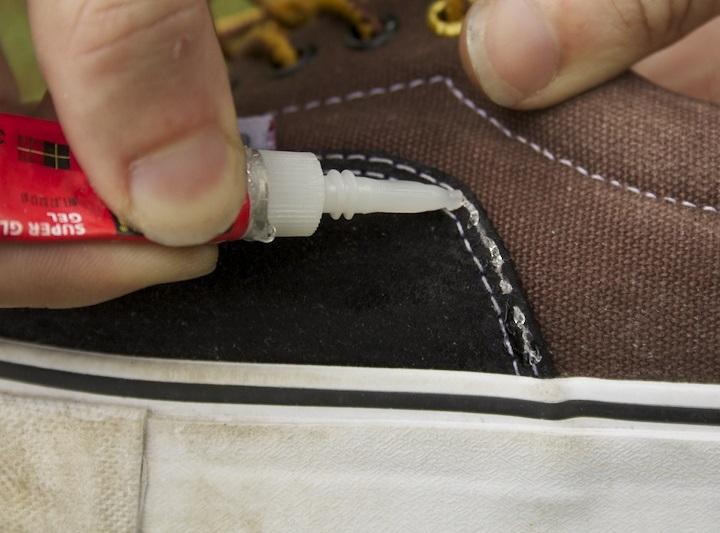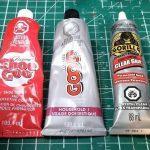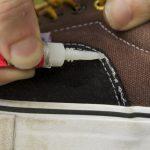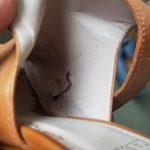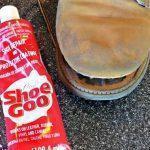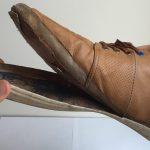You can’t use regular superglue to attach a shoe’s sole. To repair your favorite pair of shoes you can use specialized glues that bond very well but remain flexible. It is possible to super glue the sole of a shoe, but it may not be a permanent solution and may not hold up well under heavy use or different weather conditions, like cold temperatures. It is recommended to seek professional repair or replacement of the sole. Make sure you clean the sole and the upper of the shoe before you super glue the sole of broken shoes.
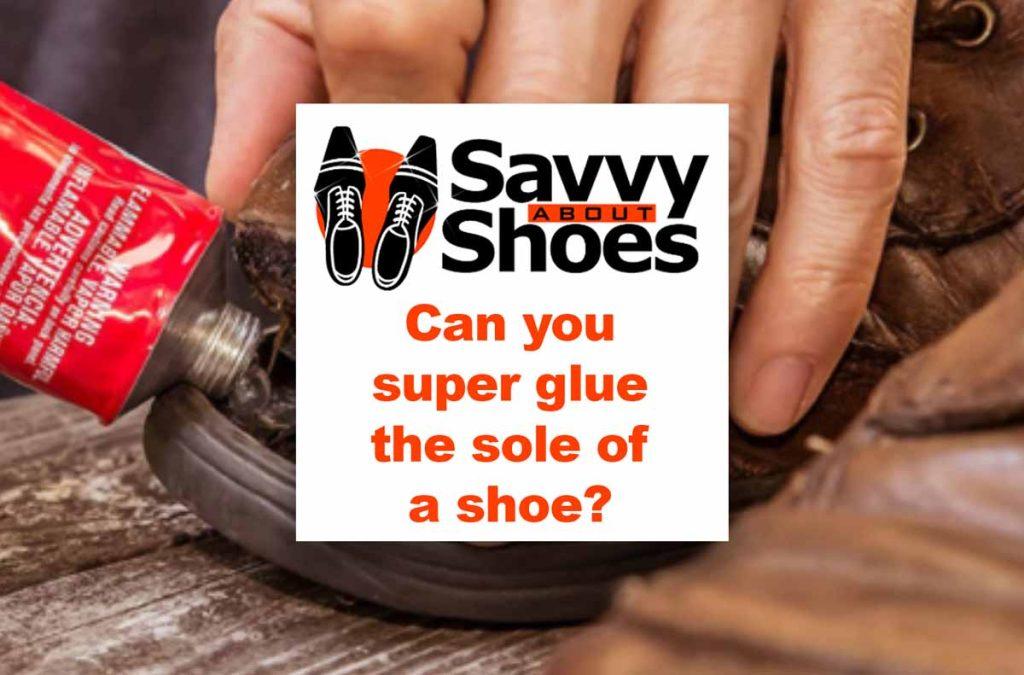
In this comprehensive article, we will explore the possibility of using super glue to fix the sole of a shoe. Discover the do’s and don’ts, tips, and potential alternatives for a successful shoe repair.
Related: Top glues for shoes repair explained and compared, Gorilla Glue Vs Shoe Goo, Shoe Goo glue Review: a great fix for your shoes
Table of content of Super glue the sole of your broken shoes
- Can you use superglue for the sole of a shoe or shoe repair glue?
Can You Super Glue the Sole of a Shoe?
No, you cannot, and you should not! Super glue will get the two sides to stay together but only until you actually put on the shoe and start walking. Super glue dries hard, while every piece of a shoe is elastic and designed to fold and bend, which the sole will come undone in a matter of hours and will leave you with a whole new bunch of problems. You must use a specialized shoe repair glue, sometimes refered to as super glue
Joachim
Jump immediately to the FAQ section

Super glue, also known as cyanoacrylate adhesive, is a powerful adhesive used to bond various materials. It is popular for its quick-drying and strong bonding properties. When it comes to fixing the sole of a shoe, using super glue might seem like a tempting solution. However, it’s essential to consider the material of the shoe and the specific adhesive you are using.
My Expert tip: While super glue can temporarily fix certain shoe materials, it is not the ideal long-term solution for all types of shoes.
Another bonus piece of advice: Be vary careful with the use of shoe adhesive or shoe fix glue. Take care of your fingers while you repair your shoes! If super shoe glue ends up on unintended parts, learn more on how to remove shoe glue, down this page.
Related: Shoe sole repair, how to fix your shoes with shoe repair glue, using super glue for shoe sole, Best shoe glue for sneakers
Factors to Consider Before Using Super Glue on Shoe Soles
Before attempting to fix your shoe sole with super glue, there are several factors you should take into account to ensure a successful repair:
1. Shoe Material and Type
Different shoes are made of various materials, such as leather, rubber, canvas, or synthetic. The effectiveness of superglue can vary depending on the shoe type and its material. For example, super glue might work better on rubber-soled shoes than leather-soled ones.
2. Degree of Damage
The extent of damage to the shoe sole plays a significant role in determining whether superglue can be a viable solution. Super glue might work well if the sole has minor detachment or small cracks. However, consulting a professional cobbler for significant damages or complete detachment is best.
3. Quality of Super Glue
Not all super glues are created equal. Some are specifically formulated for shoe repair, providing flexibility and resilience to withstand the stress of walking or withstand extreme temperatures. Choose a high-quality superglue specifically designed for shoe repairs for the best results.
4. Surface Preparation
To enhance the bonding strength, ensure the surfaces are clean, dry, and free from dust, grease, or debris. Roughening up the surfaces slightly with sandpaper can also improve adhesion.
How Do You Remove Super Glue from Shoes?
Effective glue removers are available when dealing with Super Glue residue on leather materials. To use these removers, follow these steps:
- Lightly cover the glue stain with the chosen glue remover product.
- Place a folded piece of tissue paper over the stain.
- Leave it overnight to allow the remover to work on the glue.
- Remove the tissue; most of the glue should come off with it.
- Wipe the surface clean to reveal the restored leather.
However, if you prefer not to use glue removers, there are alternative methods:
- Acetone: Dab a small amount of acetone on the glue stain using a cotton ball. Gently rub the area until the glue starts to dissolve. Wipe clean with a damp cloth.
- Nail Polish Remover: Similar to acetone, nail polish remover containing acetone can also remove Super Glue from leather. Use it sparingly and wipe it clean afterward.
- Warm, Soapy Water: For a gentler approach, soak the glue-stained area in warm soapy water. After a few minutes, gently scrape off the glue with a plastic scraper. Repeat if needed and dry the leather thoroughly.
Remember to test any alternative method on a small, inconspicuous area of the leather first to ensure it does not cause damage.
What Glue Should You Use for Shoes?
When searching for the best shoe glue, it’s crucial to consider key factors like color, waterproof capability, temperature resistance, and durability. Here’s what to look for:
- Flexible Bond: Opt for a shoe glue that maintains the shoe’s flexibility, ensuring it remains wearable without stiffening. A flexible drying glue guarantees a long-lasting seal.
- Easy Application: Look for a thicker formula and an applicator like a brush to prevent glue from spreading and damaging the shoe.
- Durability: Choose a shoe glue that provides a strong, long-term bond to ensure your repaired shoes last through various conditions, from snowy roads to dance floors.
- Waterproof Formula: For repairs on winter boots, rain boots, or any shoes that face the elements, a waterproof shoe glue is essential, especially for sole repairs.
Therefore, you need to find a type of glue that dries flexible. I have written an entire article on what the best glue for shoes is, but, if you don’t feel like reading that article, your main choices are between Gorilla Glue and Shoe Goo .
There is a third alternative, contact cement, which is my favorite, but I would really encourage you to read the article on the best glues first. There I have provided you not only with links to each individual product, but I also have discussed the advantages and disadvantages of each one and imparted some of my own hands-on experience.
However, it would seem that despite may constant advocacy for contact cement, most people land on using either Gorilla Glue or Shoe Goo, and there are constant debates on which is the best. So, before I let you get back to actually fixing your shoes, here is my two cents worth on that debate.
Gorilla Glue vs Shoe Goo
Shoe Goo is one of the oldest glues on the market designed specifically to be used on shoes. If applied correctly it will protect the shoe, meaning it will not dissolve or start eating into the fabric of the shoe, and it will give you a bonding strength similar to the one you would have had when the shoe was coming off the assembly line.
The problem with Shoe Goo is that it needs to be applied very specifically. You need to have the sides glued perfectly clean and free from debris. You must clamp the shoe tightly and keep it closed for 24 hours. Because you need to clamp the shoes down, you may need to glue the shoes in two sessions.
The first time you will glue the bottom of the shoe, let it cure, and then you will attempt to glue the tip of the shoe. Good luck finding a clamping position that will help with those type of shoes where the tip of the sole comes up and over the tip of the shoe.
Gorilla Glue, on the other hand has none of those problems. It represents a nice balance between super glue and Shoe Glue. It cures in about an hour, but it also stays flexible once it is done.
Related: Gorilla Glue Vs Shoe Goo review
If you do not have a clamping system I would suggest just turning on a TV show, applying the glue and relax while you keep the two sides being glued together. After about 20 minutes you should check because the curing should be well underway, and you may not need to keep holding on, because there’s already a strong bond.
The problem with Gorilla Glue is that it is too much like super glue for some people. It does cure flexible, but it is not quite as a flexible glue as specifically designed shoe glue. It also permeates part of the shoe and the sole, making them slightly more rigid. Outsole gaps not only keep water from entering your shoes, but can also cause shoes to squeak? As such, Gorilla Glue is an effective shoe adhesive to solve your how to stop shoes from squeaking issue!
I have tried Gorilla Glue and was completely satisfied with the results. It also dries faster so it is my favorite over the Shoe Goo. Still, I should note that most of my shoes have a fairly rigid sole. If I were to fix some running shoes, I would use Shoe Goo just to be safe because the glue I use is just as flexible as any shoe.
How to Super Glue the Sole of a Shoe Properly
If you’ve carefully considered the factors mentioned above and are confident that super glue is the right choice for your shoe repair, follow these steps to ensure a proper application:
1. Clean and Prepare the Surfaces
Thoroughly clean both the shoe sole and the detached part of the sole. Use a mild soap or cleaning solution to remove any dirt or debris. Allow the surfaces to dry completely before proceeding.
2. Apply Super Glue
Carefully apply a small amount of super glue on both the shoe and detached sole parts. Be cautious not to use excessive shoe repair glue, as it can seep out and create a mess. Press the two surfaces firmly together and hold them in place for a few minutes to allow the bond to form. When done, clean the shoe repair glue nozzle with a cloth or paper towel.
3. Let It Dry
Once the sole is firmly attached, refrain from using the shoe for a few hours to let the glue fully dry and cure. Refer to the super glue package instructions for the recommended drying time.
4. Test the Bond
After drying, gently test the bond by flexing the shoe sole. The repair should be successful if the bond feels secure and there are no signs of detachment. (what is often referred to as a durable bond)
Can Super Glue Be Used for All Shoe Repairs?
While super glue can quickly fix certain shoe repairs, it is unsuitable for all situations or any type of shoe. For example, if your shoe’s sole is severely damaged, completely detached, or made of delicate materials like suede, using super glue may cause further harm and not provide a lasting solution. LSI Keyword: Alternative shoe repair methods, shoe repair adhesives.
Related: How to Fix Peeling Shoe Lining : a comprehensive guide, How to reattach broken heels
Alternative Shoe Repair Methods
If superglue is not the best option for your shoe repair, consider these alternative methods:
1. Shoe Repair Adhesives
Specialized shoe repair adhesives available in the market offer better flexibility and durability for various shoe materials. Look for adhesives designed specifically for the shoe and sole you need to repair. You will need a different approach to repairing athletic shoes than dressed suede shoes.
2. Shoe Repair Kits
Shoe repair kits have all the tools and materials to fix shoe soles effectively. These DIY shoe repair kits often include adhesives, patches, and other accessories needed for a durable repair. Learn more about the best kit with shoe fix here.
3. Professional Shoe Repair
When in doubt or if the shoe damage is extensive, seeking help from a professional cobbler or a shoe repair shop is the wisest choice. They have the expertise and tools to assess the damage accurately and provide a reliable and long-lasting repair.
Results of using superglue to repair your shoes (video)
Frequently asked question (FAQ)
How do you glue shoes?
Follow these basic steps to glue your shoes properly.
- Wash and dry the shoe so the glue is not obstructed by dirt.
- Prepare your shoe glue according to the manufacturer’s directions, if applicable. Some types of glue (cyanoacrylate, for instance), can be used without preparation.
- Bring on a thin layer of glue to the damaged area. (both sides)
- Press the damaged parts back together, ensuring the glue has an even dispersion across the entire surface
- Allow the shoe to dry and cure
Is shoe glue the same as super glue?
Some shoe glues are super glue, so you might think it’s ok to glue the sole of a shoe super; however, not all shoe repair glue is the same, and other common types include urethane and neoprene cement.
Q: Can I use super glue to fix my leather-soled shoes?
A: While super glue can be used for some shoe materials, it may not be the best choice for leather-soled shoes. Leather requires a more flexible adhesive to allow natural movement.
Q: How long will the super glue repair last?
A: The longevity of the repair depends on several factors, including the shoe material, the quality of the glue, and the extent of damage. In general, a well-done super glue repair can last for several months to a year.
Q: Can I still use shoe repair adhesives if I’ve already tried super glue?
A: Yes, you can still use shoe repair adhesives even after attempting a super glue repair. Clean off any existing super glue residue before applying the new adhesive.
Q: Is it safe to use super glue for DIY shoe repairs?
A: Super glue can be safe for DIY shoe repairs when used carefully and following safety guidelines. However, taking proper precautions and avoiding contact with the skin or eyes is essential.
Q: Can I use super glue to fix sports shoes?
A: Sports shoes often undergo rigorous activities, and the sole may experience higher stress. It’s best to use specialized shoe repair adhesives designed for sports shoes for a more reliable fix and durable bond.
Q: How can I prevent shoe sole detachment in the future?
A: To prevent shoe sole detachment, avoid exposing your shoes to extreme temperatures, excessive moisture, or rough surfaces. Regularly inspect your shoes for wear and tear signs and promptly address minor damages.
Conclusion on can you super glue the sole of a shoe
In conclusion, while using super glue to fix the sole of a shoe might be a tempting quick fix, it is not always the most appropriate solution for all shoe materials and damages. Before attempting any repair, consider the shoe’s material, the damage extent, and the adhesive’s quality. For significant damages or delicate materials, seeking the help of a professional cobbler is recommended. Remember to follow safety guidelines when using super glue and explore alternative shoe repair glue methods for a more lasting and reliable fix.
Remember, the key to successful shoe repairs lies in understanding the materials and using the right tools and adhesives for the job. Happy shoe repairing!

